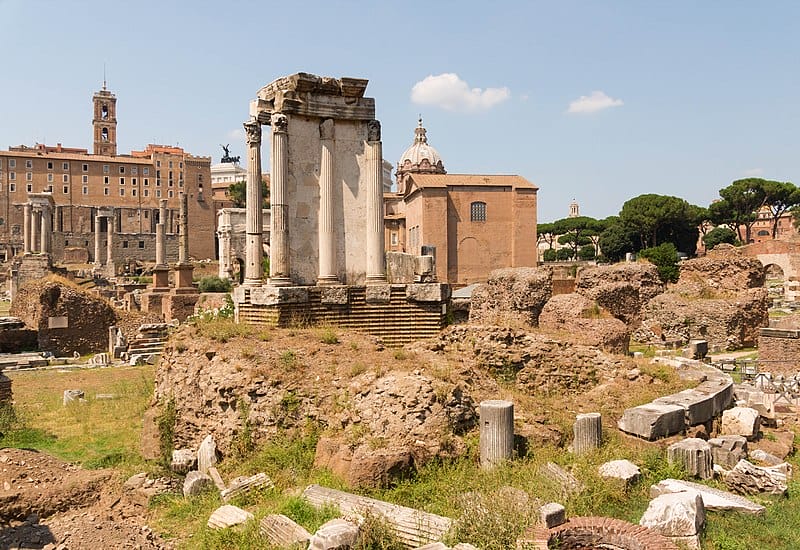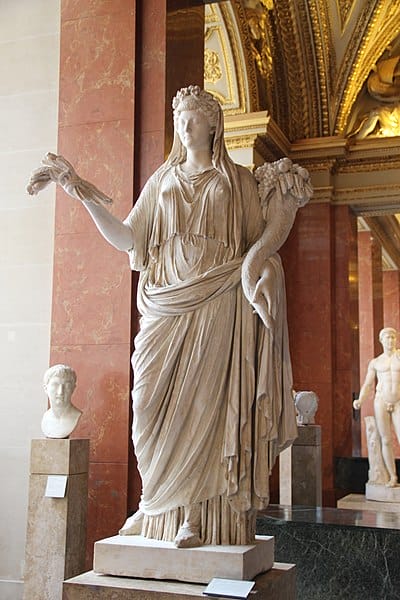Women in the Roman Empire were often overlooked in historical accounts, with their accomplishments and contributions overshadowed by those of their male counterparts. However, there were many distinguished women who played significant roles in Roman society. These women defied societal expectations and norms, paving the way for future generations of women to achieve greatness.
One such woman was Livia Drusilla, the wife of Emperor Augustus. Livia was known for her intelligence, political savvy, and influence over her husband. She played an active role in shaping the policies of the empire and was instrumental in securing the succession of her son Tiberius as emperor after Augustus’ death.
Another notable woman was Agrippina the Younger, the mother of Emperor Nero. Agrippina was a powerful and ambitious woman who was not afraid to use her influence to further her own interests and those of her son. She played a key role in Nero’s rise to power, but her ambition ultimately led to her downfall when Nero had her assassinated. Despite her tragic end, Agrippina remains a fascinating figure in Roman history.
Political Influence of Women in the Roman Empire
Women in the Roman Empire played an important role in politics, and some even rose to the position of empress. The empresses had significant influence over their husbands, who were the Roman Emperors. They often advised their husbands on political matters and even made decisions on their behalf.
Although women were not allowed to hold public office in the Roman Empire, some women were able to exert political influence through their husbands or by other means. Some women were even able to attend Senate meetings, albeit as spectators.
One such example is Cornelia Africana, the daughter of Scipio Africanus. She was known for her intelligence and was respected for her opinions on political matters. She was also a patron of the arts and was known for her support of Greek culture.
Another notable woman was Fulvia, the wife of Mark Antony. She was known for her political activism and played a significant role in the civil war that followed the assassination of Julius Caesar. She was also one of the first Roman women to appear on coins, a symbol of her political influence.
Overall, women in the Roman Empire were able to exert political influence through their husbands or by other means. While they were not allowed to hold public office, their intelligence and political savvy allowed them to play an important role in the politics of the time.
Social and Economic Status
Patrician women in the Roman Empire enjoyed a high social status due to their noble birth and family connections. They were well-educated and often involved in politics and business. Some famous patrician women include Cornelia Africana, the mother of the Gracchi brothers, and Agrippina the Elder, the mother of Emperor Caligula.

Plebeian women, on the other hand, were from the lower classes and had limited opportunities for education and advancement. They were mostly involved in domestic duties and raising children. However, some plebeian women were able to gain wealth and power through trade or by marrying into wealthy families.
Women and Slavery
Slavery was a common practice in the Roman Empire, and women were often enslaved for domestic work or as concubines. However, some women were able to gain their freedom and even become successful business owners. One such example is the freedwoman Eumachia, who was a wealthy patron of the city of Pompeii and had a public building named after her.
Women in the Roman Empire had varying social and economic statuses depending on their birth, class, and personal circumstances. Despite limitations, some women were able to achieve success and recognition in their fields.
Religious Roles and Priestesses
Women played a significant role in the religious practices of the Roman Empire. The Roman religion was polytheistic, and women were often involved in the worship of various gods and goddesses. Women were also appointed as priestesses in various temples.
The Vestal Virgins were the most famous group of priestesses in Rome. They were responsible for maintaining the sacred fire in the Temple of Vesta, the goddess of the hearth. The Vestal Virgins were selected from noble families and were required to take a vow of chastity for 30 years. They were highly respected and had many privileges, including the ability to own property and the right to vote.

Other priestesses in Rome included the Flaminica Dialis, the wife of the Flamen Dialis, the high priest of Jupiter. The Flaminica Dialis was responsible for performing certain religious rites and was required to be a virgin when she married the Flamen Dialis.
The Sibylline priestesses were also important religious figures in Rome. They were responsible for interpreting the Sibylline Books, a collection of prophecies that were consulted in times of crisis. The Sibylline Books were kept in the Temple of Jupiter Optimus Maximus on the Capitoline Hill.
Women played an important role in the religious practices of the Roman Empire. They held various positions as priestesses and were highly respected for their devotion to the gods and goddesses.
Cultural and Educational Contributions
Women in the Roman Empire supported various forms of art, including poetry, music, and dance. One of the most prominent examples is Livia Drusilla, as she was a great supporter of the arts and sponsored the works of many poets and writers. Her support helped to establish the Golden Age of Latin literature.
Another notable patroness of the arts was Julia Domna, the wife of Emperor Septimius Severus. She was a skilled musician and composer and encouraged the development of music in the empire. She also supported the works of many poets and writers, including the famous philosopher and writer Philostratus.
Female Scholars
They also made significant contributions to education and scholarship. One of the most famous female scholars was Hypatia of Alexandria. She was a mathematician, philosopher, and astronomer who taught at the Neoplatonic school in Alexandria. She was renowned for her knowledge and wisdom and attracted many students from all over the empire.
Cornelia Africana was the daughter of Scipio Africanus, one of the most famous generals in Roman history. Cornelia was well-educated and highly respected for her intelligence and knowledge. She was also a benefactor of the arts and supported many poets and writers.
Their role in the Roman Empire was huge, and women made significant cultural and educational contributions. They were patrons of the arts and supported the development of literature, music, and other forms of art. They were also scholars and educators who contributed to the advancement of knowledge and learning.
Prominent Figures
Livia Drusilla was the wife of the first Roman Emperor, Augustus. She was known for her intelligence, political astuteness, and influence on her husband’s policies. Livia was also a patron of the arts and a skilled diplomat. She played a significant role in the politics of the early Roman Empire and was highly respected by her contemporaries.

Agrippina the Younger was the sister of the Roman Emperor Caligula and the mother of Emperor Nero. She was a powerful figure in her own right and was known for her intelligence, ambition, and political acumen. Agrippina was also a patron of the arts and a skilled diplomat. She played a significant role in the politics of the early Roman Empire and was highly respected by her contemporaries.
Julia Domna was the wife of the Roman Emperor Septimius Severus. She was known for her intelligence, political astuteness, and her influence on her husband’s policies. Julia was also a patron of the arts and a skilled diplomat. She played a significant role in the politics of the early Roman Empire and was highly respected by her contemporaries.
These three women were prominent figures in the Roman Empire and contributed significantly to the politics and culture of their time. Their intelligence, political acumen, and patronage of the arts made them highly respected by their contemporaries and ensured their lasting legacy in history.
People Also Ask:
Who was the ideal Roman woman?
According to Rome’s legal and social code – written and unwritten -the ideal Roman woman was a matron who spun her own cloth, oversaw her family’s affairs, provided her husband with children, food, and a well-run household, and displayed suitable modesty. Females who defied this stereotype have often ended up as outcasts.
Who was the female Roman commander?
The Roman Empress, Fulvia, was a female Roman General (let’s face it). She led a Roman army in battle solo while her husband, Mark Antony, was away in Egypt and survived.
Were women respected in the Roman Empire?
Defined by the men in their lives, women in ancient Rome were valued mainly as wives and mothers. Although some were allowed more freedom than others, there was always a limit, even for the daughter of an emperor. Not much information exists about Roman women in the first century.
Who is the most beautiful woman in Roman mythology?
Known as Venus, she came to symbolize Rome’s imperial power. Like her Greek counterpart Aphrodite, Venus was intimately associated with love and beauty, yet other elements were distinctive to the Roman goddess.
Who was the female warrior in the Roman Empire?
Cleopatra had played for the highest stakes possible in the deadly male game of Roman politics. She was a true female warrior in that, with intelligence and relatively full agency, she had deployed her nation’s considerable resources in support of Antony and his bid for power.
Was there ever a female gladiator?
The gladiatrix is the female equivalent of the gladiator of ancient Rome. Like their male counterparts, gladiatrices fought each other, or wild animals, to entertain audiences at various games and festivals. Very little is known about them.
Hello, my name is Vladimir, and I am a part of the Roman-empire writing team.
I am a historian, and history is an integral part of my life.
To be honest, while I was in school, I didn’t like history so how did I end up studying it? Well, for that, I have to thank history-based strategy PC games. Thank you so much, Europa Universalis IV, and thank you, Medieval Total War.
Since games made me fall in love with history, I completed bachelor studies at Filozofski Fakultet Niš, a part of the University of Niš. My bachelor’s thesis was about Julis Caesar. Soon, I completed my master’s studies at the same university.
For years now, I have been working as a teacher in a local elementary school, but my passion for writing isn’t fulfilled, so I decided to pursue that ambition online. There were a few gigs, but most of them were not history-related.
Then I stumbled upon roman-empire.com, and now I am a part of something bigger. No, I am not a part of the ancient Roman Empire but of a creative writing team where I have the freedom to write about whatever I want. Yes, even about Star Wars. Stay tuned for that.
Anyway, I am better at writing about Rome than writing about me. But if you would like to contact me for any reason, you can do it at [email protected]. Except for negative reviews, of course. 😀
Kind regards,
Vladimir
